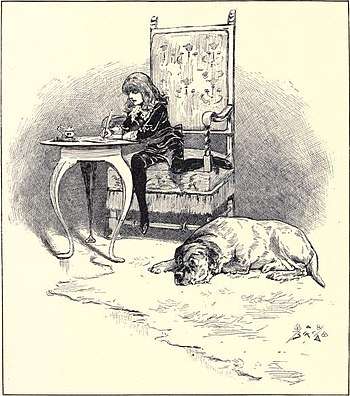Little Lord Fauntleroy

Little Lord Fauntleroy is a children's book by Frances Hodgson Burnett, originally serialized in St. Nicholas Magazine in 1885, and published on its own in 1886.
Poor American boy Cedric Errol is a fatherless child growing up in New York City in the 1880s. It's revealed that he is, in fact, the sole remaining heir to the Earl of Dorincourt in England and has the title of Lord Fauntleroy. So Cedric is taken to England to live with the Earl, his grandfather, so that he can learn to be a proper noble. Cedric's mother settles nearby, but the selfish and bitter Earl refuses to acknowledge the commoner his son married.
Over time, Cedric's compassion, intelligence and devotion to social justice capture the Earl's heart, and the old man softens, eventually asking Cedric's mother to forgive him during a crisis that Cedric's friends help solve.
The novel was especially popular with women with small children, since Cedric's fine qualities are explicitly shown to be caused not by his heredity, but the loving relationship he has with his mother. It was quickly adapted for the stage, and Ms. Burnett's successful lawsuit over her rights in regards to theatrical performances established a precedent in copyright law.
It's been adapted for film several times (once with Mary Pickford in the title role!) and into an Anime series as part of the World Masterpiece Theater.
- Adorably Precocious Child: Cedric, and how. On stage, and in the early movies, he was often portrayed by a girl or young woman to get the cuteness factor right.
- Mary Pickford, in fact, doubled in the 1921 film adaptation the roles of Cedric and his mother.
- The 10-year-old Buster Keaton played Cedric on stage. How cute could it be?
- Not only is he physically cute, but he was very well behaved, polite, responsible, is very attached to his mother etc. Basically every mother's dream son, which is not surprising considering it was written by a Victorian-era middle-class lady.
- Aristocrats Are Evil: The Earl isn't evil, but he does start the novel as a stuffy, narrow-minded and cold-hearted man. He acknowledges that Cedric will be a better Earl than he ever was.
- Disappeared Dad: Cedric's father dies before the beginning of the book.
- Flanderization: In the novel, the author is careful to show Cedric's masculine athleticism and love of sports. But for many boys of the time, who had mostly seen the less active theatrical versions, what they remembered was a vain, sissified mama's boy.
- Grande Dame: Uppah-uppah crust Englishwoman Lady Costanza Lorridale is the kindlier version of this.
- Hair of Gold
- The Red Stapler: The descriptions of Cedric's adorable velvet-and-lace outfits and long curled ringlets, combined with the excellent illustrations by Reginald Birch (one of which is shown here), charmed a generation of women into dressing their little boys in a similar fashion. There was a backlash against "Little Lord Fauntleroy"-like outfits for boys a generation later, spearheaded by new fathers who remembered how much they hated these costumes.
- Donald Duck may have developed out of this backlash. The wholesome, cutesy appearance of his sailor suit clashes hard with his hot-tempered personality and occasional Jerkass actions.
- Junior, Pete's son from "Bellboy Donald," wears a wholesome, cutesy-looking "Little Lord Fauntleroy" outfit, but he's Bratty Half-Pint who annoys Donald.
- The lasting effect of this story is such that it was unacceptable throughout the western world for little boys to have long hair until The Seventies. Eighty-five years!
- The Red Stapler: See above.
- Nice Hat: They were usually accompanied by a hat.